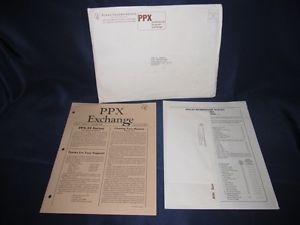This is the thirteenth in the series of “20 Questions with Wally Rhines”
My development of a calculator program to determine the Black Scholes value for an option was not the only application that attracted financial people to programmable calculators. As the SR-52, and later TI 59, grew in popularity, and took market share from the HP 65, we began to discover a vast community of innovative people writing programs for these calculators. Peter Bonfield and Stavros Prodromou drove the formation of PPX -52 Professional Program Exchange, a forum where a contributor of a useful, well documented program could receive credits for the purchase of other programs. As these programs accumulated, TI moved to publish booklets of programs on various topics and sold them. Because of the success of my Black Scholes program, and because we were short of person power, I was appointed to provide management supervision for the PPX Xchange.
Each month, we met to review the new programs that had been submitted. It was at that point that I began to comprehend the enormous resource available to us. Thousands, maybe millions, of talented people wanted to demonstrate their expertise through programmable calculator programs. In most cases, they didn’t care if they were compensated. They just wanted to show other people how brilliant they were.
The ultimate example came when I reviewed a program for a “one armed bandit” that simulated a Las Vegas slot machine. By loading the program and then pressing “enter”, the display showed three single digit random numbers separated by dashes. Dashes? There were no dashes on the SR 52 or TI 59 calculators. How could they possibly have done this? It took one of our expert engineers to analyze the program and figure out how it worked. The creator of the program had discovered that execution loops could be created that would simultaneously display more than one number; since the segments in the LED displays were strobed at about 14 times per second, the program could create overlap and thus a dash between numbers. The program was so brilliant that we contacted the author to see if he wanted to work for TI. Similarly, the SR 52 had extra, undocumented registers that programmers discovered and used for applications that were not anticipated by the developers of the SR 52.
Over the next year, many communities of people became connected through their common interest in different applications. TI’s published booklets of applications carried contact information for the authors of programs. Although there was no internet for authors to communicate, they found ways to share information. TI then sponsored events to showcase the diverse set of applications available for the programmable calculators. I was asked to demonstrate my Black Scholes program at one of these events in New York City where analysts and others from the financial community were targeted. Ben Rosen, the Morgan Stanley semiconductor analyst who was the most respected in the industry, came to the event. He was fascinated with the Black Scholes program and invited me to tour the trading floor at Morgan Stanley. Later, he visited Lubbock, Texas (a major trip for a New York investment banker) and we showed him what we were doing. I continued to run into Ben at conferences and other events. And then, after I moved to Houston to run the Microprocessor Division, I received a strange phone call. It was Ben. He said that he was leaving Morgan Stanley and that he and L.J. Sevin were starting a venture capital fund. And he said that he would be in Houston the following week and wondered whether I would be able to have dinner with him and L.J. Of course, I was available.
Ben gave his pitch for how Sevin Rosen wanted to set up potential entrepreneurs and fund them while they worked on ideas for new businesses. That way, any conflict of interest with present employers could be avoided. I was flattered that they would think of me. In fact, I was amazed that they would make a trip to Houston just to talk with me. A few months later it became apparent that they had not come to Houston just to talk with me, as evidenced by the announcement that Sevin Rosen would fund Compaq Computer, a Houston startup headed by Rod Canion, another TI employee.
I didn’t take advantage of Ben and L.J.’s offer. My responsibilities were growing too rapidly at the time to consider leaving TI. But since Ben had to sell rights to his semiconductor newsletter, the Rosen Electronics Letter. Esther Dyson bought it and renamed it Release 1.0 and began the reorientation from semiconductors to software. She, along with George Gilder, continued some of the semiconductor theme. When TI announced the TMS 7000 8-bit microcontroller, I made a trip to New York and did a series of one hour interviews with representatives of various electronics journals. Gordie Campbell, then CEO of SEEQ, gave the presentation with me as our alternate source for the TMS 7000. Gordie highlighted the Ethernet controller that SEEQ had embedded in their version of the TMS 7000. After giving the presentation seven times during the day, Gordie and I became bored and we switched places; I gave his presentation and he gave mine. And that’s how we met Esther, who wrote up the announcement in her newsletter and then proceeded to invite us to speak at the PC Forum each year.
The 20 Questions with Wally Rhines Series
Share this post via:








Quantum Advantage is About the Algorithm, not the Computer